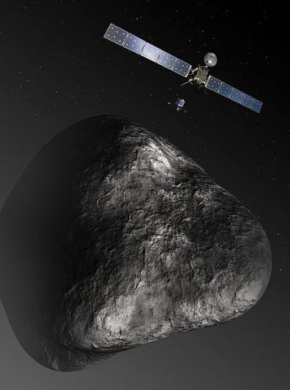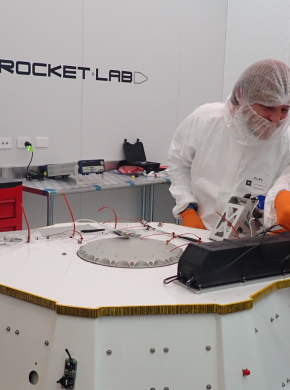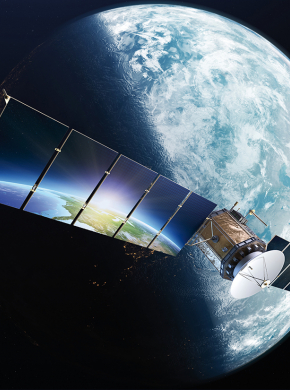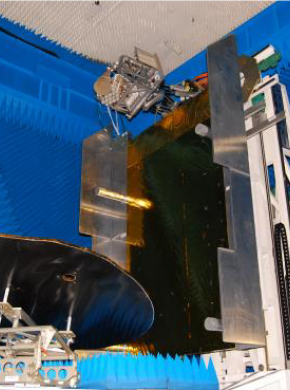The Intelligent System Initiative is a crosscutting initiative that aims to advance the autonomy of space-based systems in a disruptive way. The Initiative adopts a global system-of-system approach, exploiting synergies with application domains from a multitude of sectors. The Intelligent System Initiative works to a rapid timeframe, leveraging the most advanced processing techniques to increase system performance.
In particular, the Initiative targets leapfrog advance systems autonomy, defines the architecture of an end-to-end (E2E) system, including space and ground segments, and demonstrates key technologies for a prototype autonomous satellite. Through a collaborative effort between industry, government and academia, this initiative offers several benefits in the sustainable use of space:
-
More autonomous space-based systems will be able to operate for longer periods of time without human intervention, reducing costs and increasing reliability.
-
Substantially more autonomous space-based systems will be able to perform complex tasks, paving the way for new missions and applications with time-critical functions.
-
Autonomous space-based systems will be able to work together much more effectively, making them more efficient and powerful by making use of complex infrastructures and orchestrations.
Context
Future generations of satellites, and in particular constellations, will drastically increase autonomy to enable more complex operations, operative cost reduction, new services, including for instance resilient cyber-security applications as well as complex constellations and fleet management.
The initiative targets an end-to-end architecture that makes use of one or more satellites and a ground segment. Intelligence and the appropriate level of autonomy shall be distributed among individual space nodes, fleet or constellation and the ground segment. Multiple implementation solutions are possible, with the potential to feature master and slave nodes, thus allowing for autonomy and reliability requirements at system level. For reliability and security purposes, each node will have a local level of autonomy, a channel to feed the node health status to the higher parent group and the system, and a global system autonomy capability. The Intelligent System Initiative is complex and ambitious, with the potential to revolutionise the way we use space. By advancing the autonomy of space-based systems, it will enable new missions and applications that were not possible before.
The Programme of work
The roadmap includes a System Study under the ARTES Future Preparation programme, which will run throughout 2024, to identify the general architecture of the initiative key technology development requirements, and a first batch of basic building blocks. For these basic building blocks, ESA will open competition tenders under the ARTES Advanced Technology programme in 2024. More building blocks may stem from the System Study and will enable an In-orbit experiment (IOE) mission within the next years. The System Study encourages the use of industrial consultation, to broaden the high-level strategy beyond the specific consortium that will run the System Study itself.
The Intelligent System is a collaborative effort that strives to create an opportunity for industries to work towards a new end-to-end architecture, that encompasses standard interfaces, that covers space and ground, that targets interoperability of different blocks, sufficient level of abstraction for a flexibly reconfigurable system. Besides the Agency-driven development listed below, we welcome further Industry-initiated co-funded activities, which can be submitted via the ARTES Competitiveness & Growth open call for proposal.
The following table will progressively cover the key activities in the Intelligent System Initiative roadmap; the first one is the System Study, and then priority technology blocks will follow, covering the new avionics elements to be started in 2024.
By the beginning of 2025 the IOE procurement will be added, and during 2025, possible new blocks may be added (e.g. in the domain of payload). Entries will be regularly updated as they become ready for publication in the esa-star Publication portal:
| Workplan Title | Workplan Reference Number | Further Details |
| Intelligent Platform for Constellations | 1B.140 | Intelligent Platform for Constellations System Study |
| ARTES Advanced Technology Workplan 2024 | 4A.099 | Upcoming in esa-star |
| ARTES Advanced Technology Workplan 2024 | 4G.047 | Upcoming in esa-star |
| ARTES Advanced Technology Workplan 2024 | 4G.044 | Upcoming in esa-star |
| ARTES Advanced Technology Workplan 2024 | 4F.169 | Upcoming in esa-star |
| ARTES Advanced Technology Workplan 2024 | 4F.095 | Upcoming in esa-star |
| ARTES Advanced Technology Workplan 2024 | 3E.024 | Upcoming in esa-star |
| ARTES Advanced Technology Workplan 2024 | 4G.046 | Upcoming in esa-star |
| ARTES Advanced Technology Workplan 2024 | 7B.079 | Upcoming in esa-star |
| ARTES Advanced Technology Workplan 2024 | 4E.089 | Upcoming in esa-star |
NEWS AND EVENTS
European Space Agency’s ARTES programme introduces agile process to meet growi…
The European Space Agency’s (ESA) Advanced Research in Telecommunications Systems (ARTES) programme, through the Directorate of Connectivity and Secure Communications, is streamlining its programmatic tools to…
ARTES support leads to MDA Advanced Radiating Antenna (DRA) contract for Telesat Lightspeed
Canadian space technology company MDA has been selected to provide one of the critical technology subsystems on the Telesat Lightspeed satellites. Telesat Lightspeed is the new leading edge low Earth orbit (LEO) satellite broadband network…
GRASP: seizing the benefits of a single antenna design tool
Reflector antennas are by far the most used technology for telecom satellite and ground station antennas. TICRA, a leading provider of cutting-edge reflector antenna modelling software based in Copenhagen, has now under the ARTES programme made…
AlbaPod: the most advanced space-proven PocketQube deployer
The ‘maker’ movement in electronics and the meteoric rise of smartphones have led to a surge in small satellites - such as nano- and picosatellites (picosats are the tiniest of smallsats). But something has to propel these pocket-size payloads…
Novel flat panel antennas give drones long-range satcom capabilities
A satellite communications antenna which fits snugly into the wing of a UAV or ‘Remotely Piloted Aircraft’ (RPA) for use in long-range missions has now ‘got its wings’ – giving the green light for a variety of civilian applications across the…
'Extraordinary efficiencies’ with next-generation space solar cell
Telecommunication satellites are demanding ever-increasing power for new technologies. This makes ever-more efficient and lightweight solar generators a must for full electric propulsion satellite platforms.
AZUR SPACE, German-based…
A giant step towards satellite interference mitigation with SkyMON
Data-hungry media, like HDTV and mobile services, have made the use of satellites and their broadcasting capabilities crucial for global communications. But in order to offer these services there is a growing number of satellites required,…
Qualification of new family of hybrid solar arrays
Under ESA’s Competitiveness & Growth programme, Airbus (Ottobrunn, D) is qualifying a new family of hybrid solar arrays that is capable to deliver approximately ≈ 50% more power in the same volume and with the same weight as previous…
TESAT’s high-flying, high-performance X-band modulator: a data-relay and data-downlink star
The International Data Corporation (IDC) estimate that by 2020 there will be around 40 trillion gigabytes of data in existence. To cope with this increasing volume, data rates for satellite transmission to the ground need to be augmented. TESAT,…
Keeping Satcom Safe – Anti-jamming Solution for Antennas
Thales Alenia Space with the support of ESA has successfully developed anti-jamming antenna capabilities for reflector-type antennas – whose appeal is set to generate great interest on the commercial market.
First commercial Dutch satellite operator makes a firm footprint in Space
Two and a half years ago, the founders of Hiber wondered why only 10 per cent of the globe was covered with mobile networks, limiting the availability of the IoT (Internet of Things).
The Glasgow-based pioneer of miniaturised satellites, Alba Orbital, started the year by announcing the sale of the first two Unicorn-2 PocketQubes to US-based start-up, Stara Space.














